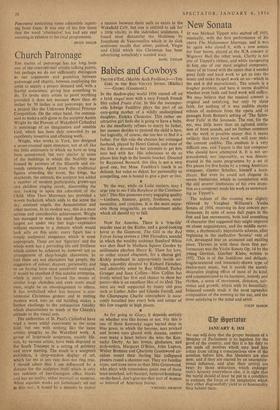New Sonata
IT was Michael Tippett who started off 1955, musically, with the first performance of his opera The Midsummer Marriage, and it was he again who closed it, with a new sonata for four horns, played at the ICA concert at Wigmore Hall the other week. Clarity' is not 'one of Tippett's virtues, and while recognising in him one of our most original composers, many of us found with the opera that it needed great faith and hard work to get us into the music and make its spell work on us—which in the end it did marvellously. The sonata is a tougher problem, and here it seems doubtful whether even faith and hard work will suffice. We may believe that the musical content is original and satisfying, but only by sheer faith, for nothing of it was audible except echoes of cadences from the opera and Of passages from Britten's setting of 'The Splen- dour Falls' in the Serenade. The rest, for the car, was little more than an agitated confu- sion of horn sounds, and no further comment on the work is possible except that it seems unlikely that even hard work will ever make the content audible. The /medium is a very difficult one, and Tippett is the last composer who should have attempted it. It is not un- precedented, nor impossible, as was demon- strated in the same programme by a set of . five pieces for five horns by a young American composer, Gunter Schuller, himself a horn- player. But even he could not disguise its severe limitations, which in conjunction with the still severer limitations of his own inven- tion as a composer made his work as unreward- ing as Tippett's.
The tedium of the evening was slightly relieved by Vaughan Williams's Violin Sonata of 1954, receiving its first concert per- formance. In spite of some dull pages in the first and last movements, both had something of character that suggested they might improve on closer acquaintance, and the middle move- ment, a rhythmically improbable scherzo, after beginning in the ineffective 'Satanic' vein of Job, developed into an animated and exciting piece. Thrown in with these three first per- formances was the Violin Sonata Op. 14 by the young German, Giselher Klebe, written in 1952. This is of the fastidious and delicate, fragile-textured and tenuously-drawn type of twelve-note music, but it avoids the merely decorative jingling effect of most of its kind, and communicated in its harmony, melody and rhythm, a sense of movement, direction, sub- stance and growth, which with its beautifully balanced sounds made it the most 'agreeable composition of the evening to the ear, and the most satisfying to the mind and spirit.
COLIN MASON


































 Previous page
Previous page